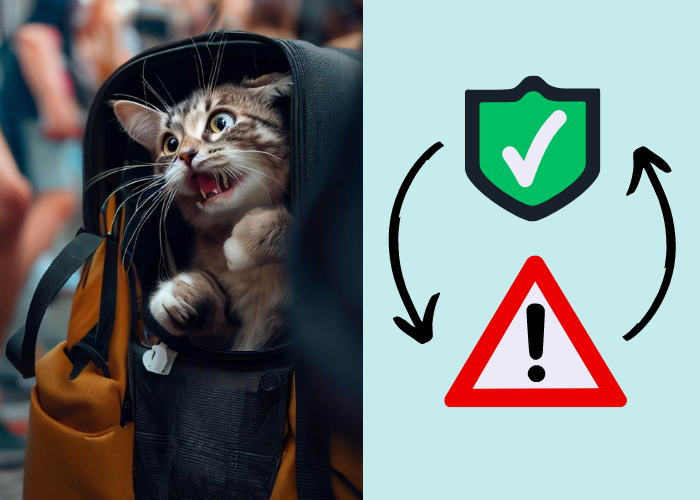Cat backpacks have gained immense popularity among pet owners as a convenient and a stylish way to transport their furry friends. However, concerns about the safety and well-being of cats in these backpacks have emerged and are well-founded. In this article, BTG will explore the safety aspects of cat backpacks, discussing both the potential risks and the measures you can take to ensure your cat’s safety. By the end, you will be convinced by BTG’s opinion that cat backpacks can be a safe and enjoyable way to travel with your feline companion.
Understanding Cat Backpacks

Cat backpacks, also known as cat carriers or cat backpack carriers, are specially designed bags that allow you to carry your cat on your back while keeping your hands free. These are specially designed and typically feature a comfortable and secure interior compartment for your cat, as well as mesh windows for ventilation and visibility. They come in various sizes, designs, and materials to suit different preferences and cat sizes.
Benefits of Using Cat Backpacks

Using cat backpacks offers numerous advantages for both you and your feline companion:
a. Enhanced Safety: Cat backpacks provide a secure and enclosed space for your cat, reducing the risk of them escaping or getting injured during transportation.
b. Stress Reduction: Cats, like any other beings are known for their sensitivity to new environments and experiences. Cat backpacks can offer a sense of security and familiarity, helping to reduce fear and anxiety during travel.
c. Increased Bonding: Carrying your cat in a backpack allows for close physical contact and creates an opportunity for bonding. It enhances the bond between you and your furry friend, promoting trust and companionship. With its convenience, you won’t hesitate carrying them to countless places, hence keeping them closer to you more often.
d. Hands-Free Convenience: Cat backpacks allow you to move freely while keeping your hands available for other tasks, such as opening doors or carrying luggage. In this manner the cat would add more fun to your routine, instead of being a concern.
Ensuring Cat Safety

While cat backpacks can be safe for your feline companion, it is essential to take certain precautions to ensure their well-being. Follow these tips to ensure a safe and comfortable experience for your cat:
1. Choose the Right Size: Select a backpack that provides enough space for your cat to turn around, wiggle, stretch, and lie down comfortably. The backpack should also have proper weight distribution to avoid strain on your back.
2. Introduce Gradually: Before embarking on a long trip, introduce your cat to the backpack gradually. Start by allowing your cat to explore the backpack in a familiar and relaxed environment. Gradually increase the duration of time spent in the backpack to help your cat become accustomed to it.
3. Familiarize with Short Trips: Begin by taking short trips with your cat in the backpack, such as around the house or to nearby locations. This will help your cat adjust to the movement and vibrations associated with traveling in the backpack.
4. Monitor Temperature and Ventilation: Ensure that the backpack provides adequate ventilation to prevent overheating. Check for mesh panels and ensure there is sufficient airflow within the carrier. Avoid exposing your cat to extreme temperatures and never leave them unattended in the backpack.
5. Comfortable Interior: Line the interior of the backpack with a soft blanket or bedding to provide comfort to your cat during the journey. Additionally, consider adding familiar scents, such as a favorite toy or an item of clothing with your scent, to help your cat feel more secure.
6. Secure the Harness: Many cat backpacks come with a built-in harness or attachment point for a leash. It is crucial to secure your cat’s harness or leash to prevent accidental escape when opening the backpack.
Potential Risks and Precautions

While cat backpacks can be safe when used properly, it is important to be aware of potential risks and take appropriate precautions:
Overstimulation
Some cats may become overstimulated or anxious when surrounded by new sights, sounds, and smells during travel. Monitor your cat’s behavior closely and provide reassurance if needed. If your cat shows signs of distress, consider shorter trips or alternative transportation methods.
Motion Sickness
Like humans, some cats may experience motion sickness during travel. If your cat exhibits sign of nausea, such as excessive drooling or vomiting, consult with your veterinarian for possible remedies or alternate travel arrangements.
Weight Distribution
It is crucial to distribute the weight evenly in the backpack to avoid strain on your back and discomfort for your cat. Adjust the straps and ensure the backpack fits properly before embarking on your journey.
Escape Prevention
Double-check zippers and closures to ensure they are secure and reliable. Additionally, make sure your cat’s collar or harness is properly fitted and cannot be slipped out of.
It’s A Wrap
Cat backpacks can provide a safe and convenient way to travel with your feline companion, enhancing your bond while ensuring their comfort and well-being. By selecting the right backpack, introducing it gradually, and following the safety precautions outlined in this article, you can create a positive experience for both you and your cat. Remember, always prioritize your cat’s safety, monitor their behavior during travel, and consult with a veterinarian if you have any concerns. With the right approach, cat backpacks can be a fantastic tool for exploring the world with your beloved furry friend.




